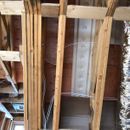Is this roof venting sufficient?
Just for quick background. We had planned to build a quite energy efficient home and had a great energy architect working with our primary architect. Our primary architect got cold feet and then refused to do anything beyond their standard. My wife wanted his architectural style so we’re stuck with standard stick frame.
Our attic is all livable space with 4′ knee walls. Roof insulation is planned to be a combination of vented where possible, hot (closed cell directly against underlayment) where venting is not possible such as dormers, valleys, etc. Insulation will be 7″ of closed cell for R-49. The consistent advice from our builder and insulation guy is that beyond R-49 is diminishing returns that’s not worth it.
Given how much hot roof we’ll already have, how critical is venting where it’s possible?
Is this an issue? A big enough issue to make something of? Or save my bullets for other things?
GBA Detail Library
A collection of one thousand construction details organized by climate and house part













Replies
If you build the vent-able areas to un-vented specs (eg, cc spray foam), then venting isn't critical. Otherwise, it is. I can't follow the pictures well enough to know if you are doing proper low to high venting.
If the roof is all spray foamed, then the venting is not needed. It doesn't hurt to leave it there, it would help with drying if there are minor roof leaks.
With a complicated roof and lots of caned pot lights, make sure the foam guys do a decent job of sealing the roof.
Something else you may want to consider is to retain a consulting engineer or another architect who specializes in energy efficient buildings. I can understand if your architect is nervous doing stuff outside the norm because he doesn't want to be putting his seal on something he’s not 100% sure he’s done correctly. Retaining a specialist might help with that concern. I’m often that specialist in my regular work since I specialize in a certain type of commerical facility that most architects and engineers don’t work with often enough to be comfortable with.
Bill
Portions with closed-cell spray foam (ccSPF): no venting required.
Portions without ccSPF (where it's just batt or other air-permeable insulation): must be fully vented.
Does that answer your question? I'm note 100% sure what you're asking when you say "how critical is it to vent where possible".
On a side note, depending on how much insulation depth you have, and what your climate zone is, you may be able to do a hybrid approach with a layer of ccSPF thick enough to control moisture, and fluff (or open-cell spray-foam) to make make up the rest of the desired R-value. This might save some money, since ccSPF is much more expensive than fluff.
"Does that answer your question? I'm note 100% sure what you're asking when you say "how critical is it to vent where possible"."
Yes. Thank you. This is, to me, quite poor venting but I also had it in my head that with closed cell (we'll have 7" in MN) the venting is not critical or as you and @akos mentioned not really needed at all.
Bill, we started out with a really good energy architect, Racheal Wagner, working with our lead architect. This was on track to produce a great result and should have produced a great result but as I mentioned our lead architect got cold feet and refused to do ANYTHING beyond their standard wall structure. It was a scuzzy thing to do after previously agreeing to it and after we'd invested a lot of money in it. Based on what this showed about both his character and his technical ability I should have been more forceful with not moving forward with him but my wife really likes his architecture (as do I) and going elsewhere would have been a huge deal for her. Very sad that this can happen in MN.
W. Ramsay,
If you've switched architects, I advise you to stick with Rachel Wagner as an energy consultant. She's a top-notch expert.
I agree completely about Rachel and really enjoyed working with her to the extent we did. She's a great person and great architect.
My wife had a very strong preference for our current lead architect from an aesthetic/design standpoint. She tried hard to like Rachel's designs and those of other architects we thought would work well with Rachel but couldn't get there.
Besides this architect taking such a negative stance towards a more sustainable house after previously agreeing to it, I think my biggest disappointment was the missed opportunity for him to have learned something about sustainable design and adding a bit more knowledge to the world.
I would say that image 1 (the portions not covered by the vent) violates this part of code: "Not less than a 1-inch (25 mm) space shall be provided between the insulation and the roof sheathing...". On the other hand, 100% coverage is never possible.
What is the air sealing plan for vented, no spray foam areas? You might want to put a thin layer of spray foam over the vents.
"What is the air sealing plan for vented, no spray foam areas? You might want to put a thin layer of spray foam over the vents."
I believe the plan is 7" of closed cell under the entire roof deck. I'm not sure that there are any no spray foam areas.
When you say thin layer of spray foam over the vents. Are you referring to the vent channels in the photos? These should all be covered w/ the 7" of closed cell.
Ah, OK. You could save money/foam by using a mix of different insulation types (even in the unvented areas).